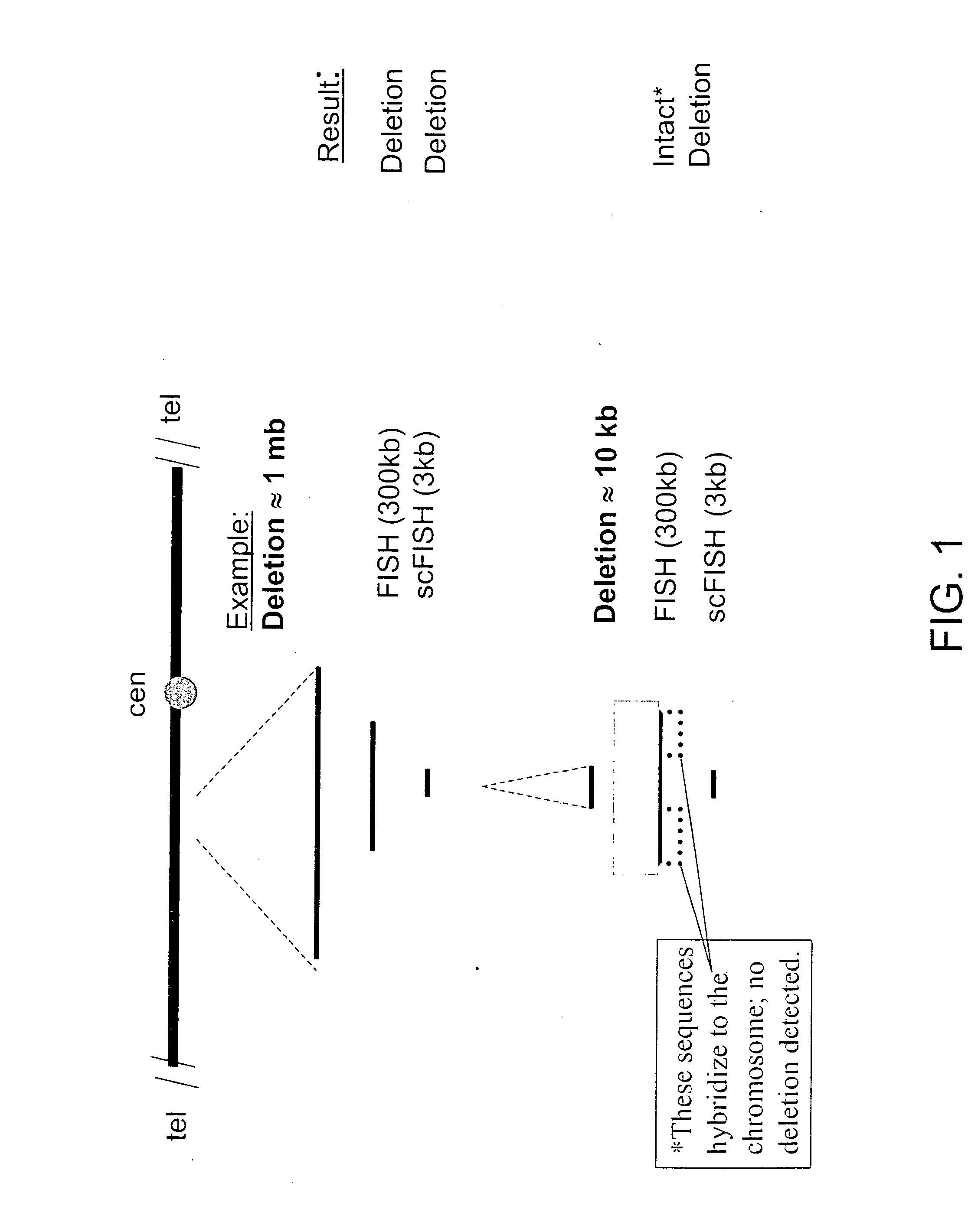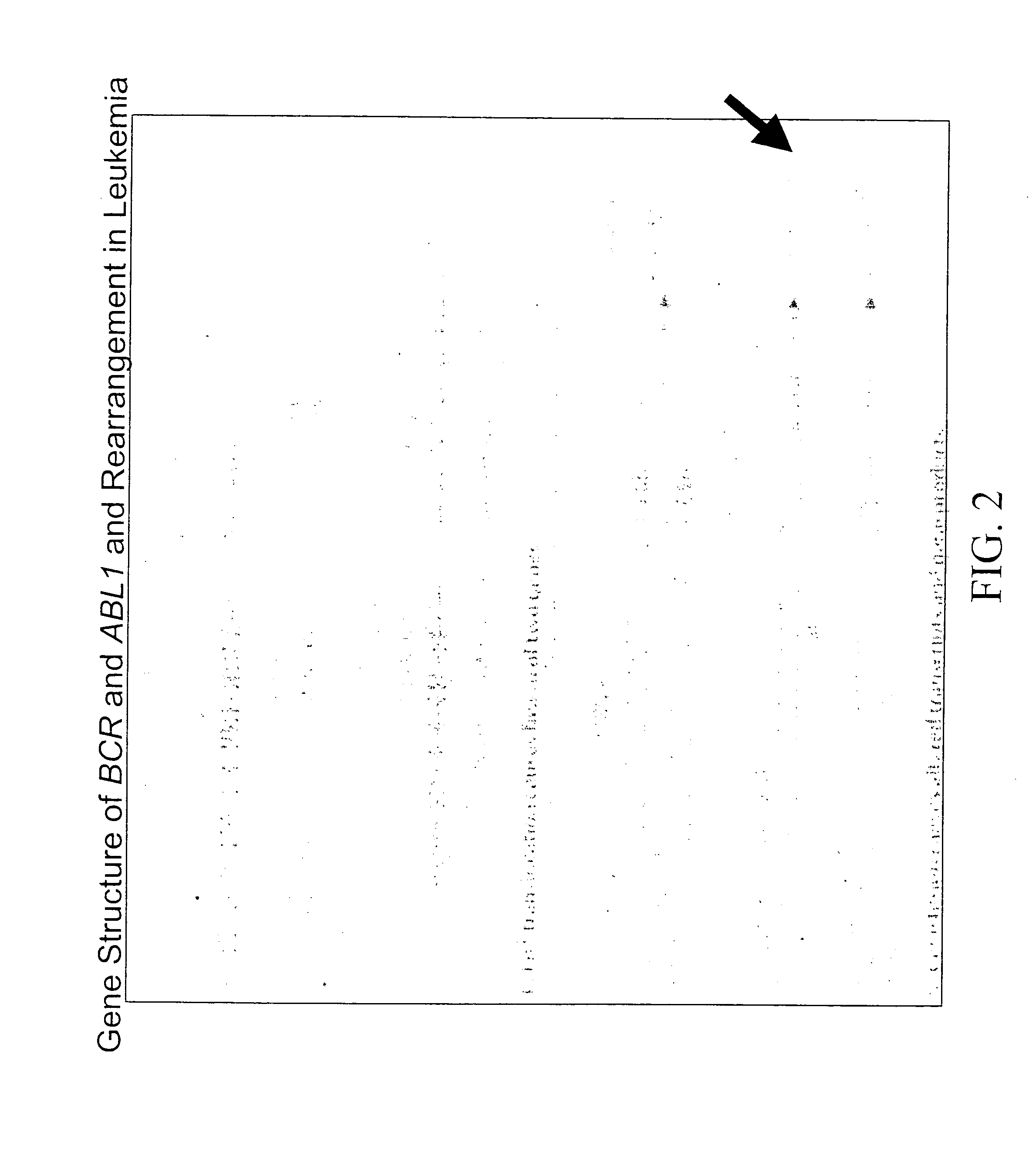Computational selection of probes for localizing chromosome breakpoints
- Summary
- Abstract
- Description
- Claims
- Application Information
AI Technical Summary
Benefits of technology
Problems solved by technology
Method used
Image
Examples
example 1
[0047] This example demonstrates the feasibility of using scFISH probes throughout the human genome and incorporates by reference the teachings and content of Rogan et al., Sequence-Based Design of Single-Copy Genomic DNA Probes for Fluorescence In Situ Hybridization, Genome Research, vol. 11, pp. 1086-1094 (2001). This was accomplished by analyzing the organization of potential single copy probe sequences on chromosomes 21q and 22q. Chromosome 21q contains a lower density of genes than chromosome 22q, and is somewhat more representative of the complete genome. The coordinates of each of the repetitive sequence elements in chromosome 21q and chromosome 22q sequences were located with the computer program CENSOR (as described in Jurka, J., Klonowski, P., Dagman, V., and Pelton, P., “CENSOR—A Program for Identification and Elimination of Repetitive Elements from DNA Sequences”, Computational Chemistry, Vol. 20, pp. 119-122, 1996, which is hereby incorporated by reference). The sequenc...
example 2
[0050] This example is illustrative of the dichotomous method of bisection of the interval for probe selection using the ABL1 oncogene as an example.
[0051] First, bone marrow samples were selected from 71 persons diagnosed with CML and determined to have a translocation between chromosomes 9 and 22 by cytogenetic GTG-banding. In brief, cells from each sample were prepared and chromosomes were digested with trypsin and then stained using a Giemsa staining procedure. After staining, the cells were visually examined with a microscope to determine whether a translocation was present. A proportion of cells from each patient sample were determined to have a 9; 22 chromosome translocation.
[0052] In patients with CML, sequences distal to intron 1b (IVS1b) of the ABL1 oncogene on chromosome 9 (which is usually disrupted) and have been translocated to the promoter of the BCR gene on chromosome 22. Additionally, approximately 10% of CML patients also have a disruption upstream from the ABL1 ...
example 3
[0059] This example illustrates a hypothetical use of the “Golden Section ratio” method of probe selection in a patient with a chromosome 9 translocation at a known breakpoint at 124,643,186.
[0060] The section of chromosome 9 used in the previous examples and including the ABL1 gene is selected for breakpoint determination. The total number of base pairs in this span of chromosome 9 is 120,990. When this number is multiplied by 0.618, the result is about 74,772. The first endpoint of this chromosome span is located at base pair 124,604,542, and so a probe should be selected that is near base pair 124,679,314. Accordingly, the first probe selected is probe 21 (as described in Example 2), which has a coordinate of approximately 124,684,469 bp. Probe 21 is then manufactured and hybridized to the chromosomes of the sample as described in Example 2. For those probes containing repetitive sequence, Cot−1 DNA is preannealed prior to chromosomal hybridization (see FIG. 3). After hybridizat...
PUM
| Property | Measurement | Unit |
|---|---|---|
| Color | aaaaa | aaaaa |
| Distribution | aaaaa | aaaaa |
Abstract
Description
Claims
Application Information
 Login to View More
Login to View More - Generate Ideas
- Intellectual Property
- Life Sciences
- Materials
- Tech Scout
- Unparalleled Data Quality
- Higher Quality Content
- 60% Fewer Hallucinations
Browse by: Latest US Patents, China's latest patents, Technical Efficacy Thesaurus, Application Domain, Technology Topic, Popular Technical Reports.
© 2025 PatSnap. All rights reserved.Legal|Privacy policy|Modern Slavery Act Transparency Statement|Sitemap|About US| Contact US: help@patsnap.com



